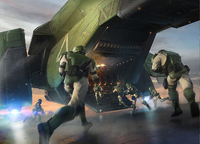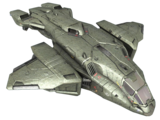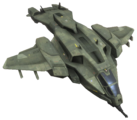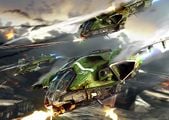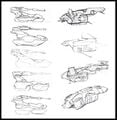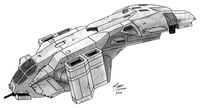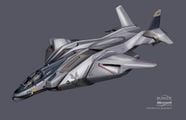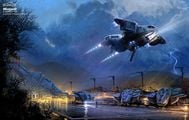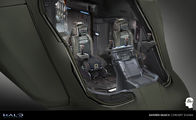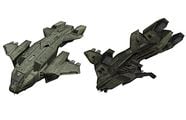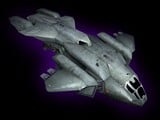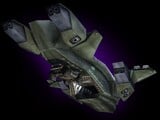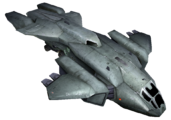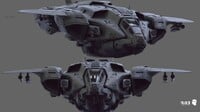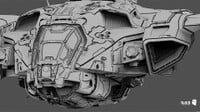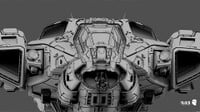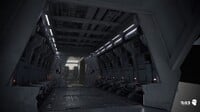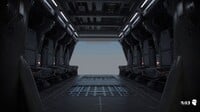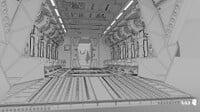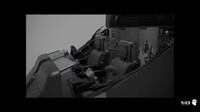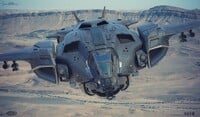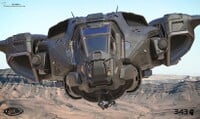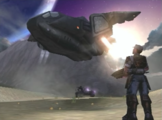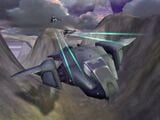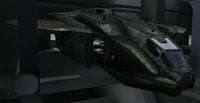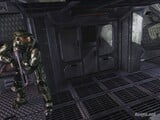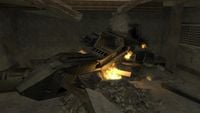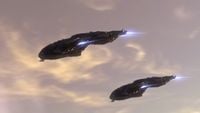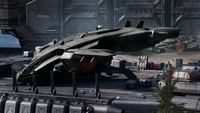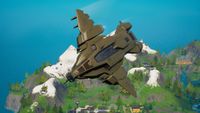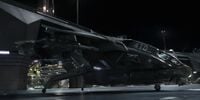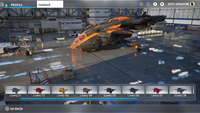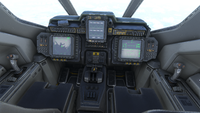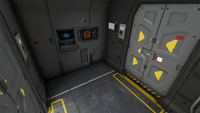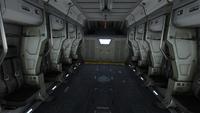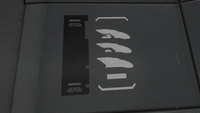D77 Pelican
From Halopedia, the Halo wiki
"WE'VE GOT A NEW CONTACT, UNKNOWN CLASSIFICATION!" This article may contain information based upon upcoming, unreleased, or recently-released content from Halo Encyclopedia (2022 edition), and may not be fully complete. Additionally, the information may be subject to change if it is based on pre-release material. Please update it as soon as any relevant and accurate material is available.
|
| This article does not meet the wiki's general standards and/or standards on layouts. You can help by cleaning this article. |
| Dropship 77 - Troop Carrier | |
|---|---|
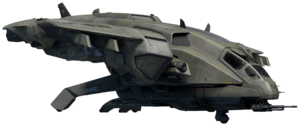
| |
| Production information | |
|
Manufacturer: |
|
|
Class: |
|
|
Role: |
|
| Technical specifications | |
|
Length: |
33.8 meters (110.9 ft)[2] |
|
Width: |
25.3 meters (82.9 ft)[2] |
|
Height: |
11.1 meters (36.5 ft)[2] |
|
Mass: |
|
|
Engine(s): |
|
|
Navigation system(s): |
|
|
Armament: |
|
|
Complement: |
|
|
Crew: |
|
| Chronological and affiliation | |
|
Era: |
|
|
Introduced: |
|
|
Affiliation: |
|
The D77 Pelican[10][3] (Formal classification: Dropship 77 - Troop Carrier),[2] commonly known as the Pelican, is an extremely versatile space-to-ground capable craft used by the United Nations Space Command, as well as being marketed toward law enforcement, security, corporate and civilian markets.[1] In its role as a tactical aerospace lifter, the Pelican is mainly for the pickup and transportation of personnel, vehicles and equipment, though some variants are capable of serving in the role of a gunship. The UNSC also uses Pelicans as civilian vehicles for quick evacuations.[11][12]
The D77-TC has been in service for over fifty years, and is the primary tactical support aircraft of the UNSC. The Pelican serves a multi-role purpose; it is fully capable of atmospheric flight and can land almost anywhere without difficulty. The Pelican is also capable of limited spaceflight, which the UNSC uses as a primary way of delivering troops to the surface from orbit.
The Pelican's standard armament consists of one Class III externally powered projectile weapon at the fore of the vehicle, and one Class I gas-operated projectile weapon mounted at the rear, in the extended crew area.[citation needed] More heavily armed variants exist, and the Pelican can be converted to a gunship role with the addition of numerous and more powerful weaponry.[13]
Design[edit]
Armament[edit]
The Pelican's primary armament consists of one or more nose-mounted projectile weapons, typically autocannons or machine guns. Commonly known as "chin guns" due to their placement,[6] these weapons are controlled via an Integrated Helmet and Display Sight System (IHADSS), which links to the pilot's or co-pilot's heads-up display and allows them to target the gun by head movements.[7][14] The Pelican's standard armament is a chin-mounted M370 autocannon, which is sometimes linked with another such weapon;[15] the M370 fires 70mm high-explosive armor-piercing (HEAP) rounds as standard ammunition,[4] with depleted-Uranium slugs also being an option.[15] This replaced the older M340 autocannon that was common prior to 2525.[8] Some Marine Corps Pelicans are armed with a single 70mm rotary machine gun instead of a chain gun.[7]
In addition to its primary armament, the Pelican has four externally-mounted missile hardpoints,[1] which typically hold twin pods of eight Anvil-II air-to-surface missiles. However, they can carry a variety of weapon systems or specialized equipment pods. A turret can be placed at the back of the cargo-bay to provide covering fire for embarking personnel, and can range from machine guns, to grenade launchers, and even a gauss cannon.[4] While some weapons can be folded against the roof when not in use, others such as the AIE-486H machine gun can not.[16]
The D77 Pelican, like most other UNSC aerospace vehicles, is fitted with a suite of countermeasures to warn the dropship of incoming attacks, break target locks, and mitigate the effects of electronic warfare. These include wide-spectrum flares, microdrone decoys, rainbow laser blinders, RADAR/LIDAR sensors, directional jammers, and "hard chop" guillotines on data processing modules that could be susceptible to cyber-intrusion agents.[4] To prevent them from being easily taken out by electromagnetic pulses, the Pelican's electronic systems are hardened against such phenomena.
Powerplant/Propulsion[edit]
Pelicans utilize a complicated system of hybrid fusion drives that combine vectored-thrust ramjets with air-breathing hyperfans in two primary and two secondary articulated engine pods. In an atmosphere, the engines function as air-breathing jets, drawing on the air for reaction mass, whereas in a vacuum, they operate on an internal supply of hydrogen reaction mass to provide thrust. With a full tank of fuel, the Pelican is able to carry out two surface-to-orbit trips.[4] The two main engines have four nacelles each, two on the bottom and two at the back. The aft engines being similar but lack a nacelle at the bottom. Because both modules are mounted on rotating blocks, they can redirect themselves from directing the thrust downwards to any direction required. A basic gravitic control system is used in-atmosphere to supply further stability and supplementary lift.[4] Although fully capable of orbital transit, the D77 is too small to be equipped with a Shaw-Fujikawa Translight Engine, and is thus incapable of slipspace travel.[citation needed]
Crew and complement[edit]
The Pelican is crewed by two personnel who occupy the cockpit at the front of the dropship. The pilot sits on the right side, with the electronics operator or gunner taking up the station on the left. All flight controls are a digital fly-by-light with no manual backups; an integral expert system optimizes stability and adjusts the thruster profiles under all regimes and cargo profiles. Unlike on the later D79H Pelican, the cockpit is only accessible from the cargo-bay. Motion trackers, RADAR/LIDAR sensors and a computerized mapping system allow the pilot to plan their way to nearby staging areas as well as to warn of incoming threats.[4]
The cargo-bay, colloquially dubbed by Marines as the "blood tray", usually accommodates up to ten personnel in jumpseats, with a small overhead compartment for their weapons and equipment. Additional infantry can be carried standing up, and increased seating for ten more people can be installed in the center aisle. Otherwise, this space can be used to carry cargo pallets, casualty litters, or even small utility vehicles such as two M274 Mongoose ULATV.[4] The Pelican is also equipped with an onboard weapons locker, which can hold enough weapons and ammunition to arm thirty troopers.[14] At least one pelican has been modified to act as a boarding craft for Operation: RED FLAG, which has enough room to ferry twenty-five SPARTAN-IIs to their target, as well as carry the cutting gear needed to cut through the hull of a Covenant warship. Pelicans equipped for "soft-seal" boarding actions have an extendable cover that folds down around the entrance to the troop bay. This configuration was refined during the last days of Operation: TREBUCHET.[17]
The large aft overhang provides a magnetic and physical attachment point for additional cargo and ordnance. Possible payloads include a troop deployment pod, a single large vehicle such as an M808 Scorpion or M12 Warthog, or eight resupply canisters. It can also transport a deployable bridge,[18] or a firebase component building. It is discouraged for pilots to transport objects in the clamp during orbital insertions, as it can complicate reentry.[4]
Variants[edit]
As the most ubiquitous Pelican model in service, the Pelican has seen extensive deployment and modification, and is widely marketed to police, security, corporate and civilian markets.[1]
- D77H-TCI Pelican — A newer and nearly identical model of the regular D77-TC, except for a more angular frame, and it features a tandem pilot-seating configuration.[10]
- D77C Pelican – A civilian variant utilized by the law enforcement agencies on major urban areas.[10]
- D77C-NMPD Pelican – A specialized variant of the D77C and the D77H-TCI itself that was employed by the New Mombasa Police Department in Kenya, Africa, Earth.[19]
- Air Force variant — The version of the Pelican used by the UNSC Air Force features a few major differences from other variants of the aircraft. First, the cockpit layout resembles that of the newer D77H-TCI model with the co-pilot's station located behind and above the pilot rather than side-by-side.[20]
- G77S Pelican — Building upon the versatile foundation of the venerable D77 airframe, the G77S Pelican is an impressive gunship design cooked up by Isabel and the UNSC Spirit of Fire's engineers to help turn the tide of battle against Banished forces on the Ark. The G77S Pelican Gunship boasts a powerful range of armaments, including top-mounted ANVIL missile pods, four payload hardpoints, a forward M370 chaingun turret, and multiple 12.7mm Vulcan cannons.[21]
- D78 Pelican — Although the D79H Pelican largely supplanted the D77 in post-war service, surviving hulls would be upgraded with improved avionics and thrusters, redesignated D78-TC and continuing to serve.[10][22]
Identified Pelicans[edit]
Service history[edit]
Human-Covenant War[edit]
By the time of the Fall of Reach, D77 Pelicans were the most common airlift assets available to NOBLE Team and other Spartans at Reach, albeit UH-144 Falcons also being used for shot-top transport and air support.[3] When the Covenant assaulted the planet, they were used to move critical assets the battlefronts across the human inner colony, and evacuate wounded and VIPs.[3] Following the UNSC disastrous defeat and the glassing of Reach in August 30, 2552, many surviving Pelicans were drawn to the sister colony of Tribute, where they continue to fight against the Covenant forces there until the end of the Human-Covenant War.[3]
Post-war[edit]
- Main articles: Battle over Installation 07, Installation 07 conflict
 This section is a stub. You can help Halopedia by expanding it.
This section is a stub. You can help Halopedia by expanding it.
Halo: Fleet Battles[edit]
UNSC Pelican Boarding Craft[edit]
- Flight slots: 0
- Movement: 12"
- Damage track: 4
- Security detail: 2
- Systems loadout: Heroic save (Trooper)
Non-canon and dubious canon appearances[edit]
Silver Timeline[edit]
- Main article: Silver Timeline
D77 Pelicans are used by the UNSC to transport troops during their war with the Covenant.[23]
Trivia[edit]

|
Browse more images in this article's gallery page. |
- A pelican is a seabird, in keeping with the UNSC's tradition of naming atmospheric vehicles after real animals, with the exceptions of the Cyclops and Gremlin, which are named after mythical creatures, and the GA-TL1 Longsword, B-65 Shortsword, FSS-1000 Sabre, and F-41 Broadsword which are named after bladed weapons.
- All Pelican dropships in Halo: Combat Evolved bear either the numbers E419 (Echo 419) or V933 (Victor 933). This was done to save resources during the development of the game.
- The Pelican shows clear inspiration from the UD4L Cheyenne dropship from the movie Aliens, which has inspired the Halo series in many ways.
- In Halo 2 gameplay, players can see the insides of the Pelican's cockpit, but no pilots are inside, despite they can be heard in COMs.
- There is a glitch in the Halo 2 level Metropolis where the player can ride in a Pelican. It will take the player out of the map, flip, and eject the player. If the player attempts to right the flipped Pelican, the script will read "Hold X to flip Banshee", because Bungie never intended for the Pelican to be operable by the player, and therefore did not make a unique message. The Pelican's in-game physics will make it impossible to correctly and permanently flip the Pelican, as it will always reposition itself in an upside-down position.
- In Halo: Reach, the player can pilot a Pelican through an Easter egg.
- In Halo: Reach, the inside screens show information on the Office of Naval Intelligence's SWORD Base.
- In Halo: Reach, all Pelicans are registered as NOBLE Team assets, as they are all given the tag "NOBLE 48".
- Its name is a reference to the number 7.
Gallery[edit]
Concept art[edit]
Very early sketches of the Pelican for Halo: Combat Evolved, before the dropship's form was finalised.
Early concept of a redesigned Pelican for Halo: Reach.
Concept art of a Pelican airfield on Reach.
Concept art of the Pelican for the Blur Studio cutscenes in Halo 2: Anniversary.
Concept art of wrecked D77 Pelicans for Halo Infinite.
Concept art of a D77-TC at the Avery J. Johnson Academy of Military Science.
Renders[edit]
A cutout of a Pelican in Halo 2: Anniversary cutscenes.
Screenshots[edit]
The Pelican as it appeared in the E3 2000 Trailer for Halo: Combat Evolved.
Sergeant Avery Johnson commandeers a Pelican's M247 bay gun.
A D77-TC on the map Fragmentation in Halo Infinite.
Echo 216, a D77 Pelican, landed at Outpost Tremonius on Installation 07.
Non-canon images[edit]
A D77 being used as a glider in Fortnite.
A D77 Pelican in Halo: The Television Series.
List of appearances[edit]
Sources[edit]
- ^ Jump up to: a b c d e f Halo: Official Spartan Field Manual, page 206
- ^ Jump up to: a b c d e f g h i j k l Halo Encyclopedia (2022 edition), page 148
- ^ Jump up to: a b c d e f g h Halo Legendary Crate - Data Drop #13: D77 Pelican Tactical Aerospace Lifter
- ^ Jump up to: a b c d e f g h i j k l m n Halo: Warfleet, page 44-45
- ^ Halo: Combat Evolved, campaign level 343 Guilty Spark
- ^ Jump up to: a b Halo: The Essential Visual Guide, page 135
- ^ Jump up to: a b c Halo: The Flood, chapter 3
- ^ Jump up to: a b Halo: The Fall of Reach, page 92: "John sized up her armaments - dented and charred armor, a pair of old, out-of-date 40mm chain guns."
- ^ Halo Infinite, campaign mission Ringfall: Warship Gbraakon
- ^ Jump up to: a b c d e Halo Waypoint, Pelican (Retrieved on Oct 30, 2021) [archive]
- ^ Halo: Reach, campaign level Exodus
- ^ Halo: Uprising
- ^ Halo Wars 2, G77S Pelican gunship in-game model
- ^ Jump up to: a b Halo: Combat Evolved: Sybex Official Strategies & Secrets
- ^ Jump up to: a b Halo: Ghosts of Onyx, Chapter 1
- ^ Halo 3, campaign level The Ark
- ^ Halo Wars: Genesis, page 20-21
- ^ Halo: Reach, campaign level Tip of the Spear
- ^ Halo Waypoint, NMPD Pelican: (defunct, archive here) (Retrieved on Mar 26, 2011) [archive]
- ^ Halo: Reach: 3D Pelican model
- ^ Halo Waypoint, Canon Fodder: The Art of War(s) (Retrieved on Mar 19, 2017) [archive]
- ^ Halo 4: The Essential Visual Guide, page 112
- ^ YouTube - Paramount+, Halo The Series (2022) Official Trailer (Retrieved on Jan 30, 2022)
| ||
| ||

